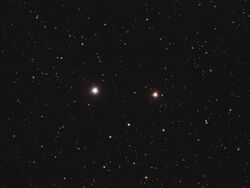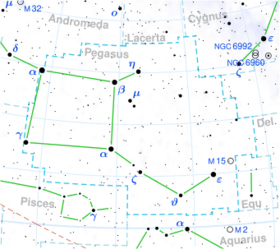Astronomy:Pi2 Pegasi
| Observation data Equinox J2000.0]] (ICRS) | |
|---|---|
| Constellation | Pegasus |
| Right ascension | 22h 09m 59.24371s[1] |
| Declination | +33° 10′ 41.5976″ [1] |
| Apparent magnitude (V) | +4.28[2] |
| Characteristics | |
| Spectral type | F5 III[3] |
| B−V color index | 0.471±0.012[2] |
| Astrometry | |
| Radial velocity (Rv) | +5.1±0.9[2] km/s |
| Proper motion (μ) | RA: −12.87±0.12[1] mas/yr Dec.: −18.95±0.16[1] mas/yr |
| Parallax (π) | 12.40 ± 0.17[1] mas |
| Distance | 263 ± 4 ly (81 ± 1 pc) |
| Absolute magnitude (MV) | 0.21[4] |
| Details | |
| Mass | 2.48[5] M☉ |
| Radius | 8.5±0.8[6] R☉ |
| Luminosity | 102.9±2.6[6] L☉ |
| Temperature | 6,300+298 −263[6] K |
| Rotational velocity (v sin i) | 139.7[4] km/s |
| Age | 530[5] Myr |
| Other designations | |
| Database references | |
| SIMBAD | data |
π2 Pegasi, Latinized as Pi2 Pegasi, is a single[8] star in the northern constellation Pegasus. It is yellow-white in hue and visible to the naked eye as a faint point of light with an apparent visual magnitude of +4.28.[2] The distance to this object is approximately 263 light years based on parallax,[1] and it is drifting further away with a radial velocity of +5 km/s.[2] This star is an outlying member of the Ursa Major Moving Group.[9]

This object has a stellar classification of F5 III,[3] matching an aging giant star that has exhausted the supply of hydrogen at its core then cooled and expanded off the main sequence. At present it has 8.5[6] times the radius of the Sun. The star is 530[5] million years old with 2.48[5] times the Sun's mass. It shows a high rotation rate considering its evolutionary status, with a projected rotational velocity of 140 km/s.[4] The star has been noted as a possible variable shell star.[10] Pi2 Pegasi is radiating 103 times the Sun's luminosity from its swollen photosphere at an effective temperature of 6,300 K.[6]
References
- ↑ 1.0 1.1 1.2 1.3 1.4 1.5 van Leeuwen, F. (November 2007), "Validation of the new Hipparcos reduction", Astronomy and Astrophysics 474 (2): 653–664, doi:10.1051/0004-6361:20078357, Bibcode: 2007A&A...474..653V
- ↑ 2.0 2.1 2.2 2.3 2.4 Anderson, E.; Francis, Ch. (2012), "XHIP: An extended hipparcos compilation", Astronomy Letters 38 (5): 331, doi:10.1134/S1063773712050015, Bibcode: 2012AstL...38..331A.
- ↑ 3.0 3.1 Herbig, George H.; Spalding, John F., Jr. (January 1955), "Axial Rotation and Line Broadening in Stars of Spectral Types F0-K5", Astrophysical Journal 121: 118, doi:10.1086/145969, Bibcode: 1955ApJ...121..118H.
- ↑ 4.0 4.1 4.2 Reiners, Ansgar (January 2006), "Rotation- and temperature-dependence of stellar latitudinal differential rotation", Astronomy and Astrophysics 446 (1): 267–277, doi:10.1051/0004-6361:20053911, Bibcode: 2006A&A...446..267R
- ↑ 5.0 5.1 5.2 5.3 Luck, R. Earle (September 2015), "Abundances in the Local Region. I. G and K Giants", The Astronomical Journal 150 (3): 23, doi:10.1088/0004-6256/150/3/88, 88, Bibcode: 2015AJ....150...88L.
- ↑ 6.0 6.1 6.2 6.3 6.4 Brown, A. G. A. (August 2018). "Gaia Data Release 2: Summary of the contents and survey properties". Astronomy & Astrophysics 616: A1. doi:10.1051/0004-6361/201833051. Bibcode: 2018A&A...616A...1G. Gaia DR2 record for this source at VizieR.
- ↑ "pi02 Peg". SIMBAD. Centre de données astronomiques de Strasbourg. http://simbad.u-strasbg.fr/simbad/sim-basic?Ident=pi02+Peg.
- ↑ Eggleton, P. P.; Tokovinin, A. A. (September 2008), "A catalogue of multiplicity among bright stellar systems", Monthly Notices of the Royal Astronomical Society 389 (2): 869–879, doi:10.1111/j.1365-2966.2008.13596.x, Bibcode: 2008MNRAS.389..869E.
- ↑ Chupina, N. V. et al. (June 2006), "Kinematic structure of the corona of the Ursa Major flow found using proper motions and radial velocities of single stars", Astronomy and Astrophysics 451 (3): 909–916, doi:10.1051/0004-6361:20054009, Bibcode: 2006A&A...451..909C.
- ↑ Hauck, B.; Jaschek, C. (February 2000), "A-shell stars in the Geneva system", Astronomy and Astrophysics 354: 157–162, Bibcode: 2000A&A...354..157H.
External links
- Kaler, James B.. "Pi Pegasi". Stars. University of Illinois. http://stars.astro.illinois.edu/sow/pipeg.html. Retrieved 16 March 2016.
 |


